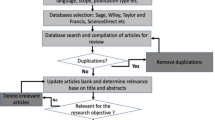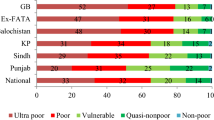Abstract
Some of the most effective public programs used in Latin America to reduce poverty and inequality have been non-contributory cash transfers. We examine country-specific characteristics that lead countries to adopt these programs over time using a state-transition spatial probit panel data model that takes into account dependence between countries’ decision to adopt these programs. Intuitively, past adoption of cash transfer programs by other countries might have an impact on the probability that a country implements this type of program. We explore alternative connectivity structures to model dependence, spatial proximity as well as connections based on population migration flows, finding out-migration as most consistent with our sample data and spatial regression specification. For our panel of 17 Latin American countries over the period 2000–2017, we find evidence of dependence between countries in the probability of adoption of conditional cash transfer programs, but no such evidence in the case of unconditional cash transfer programs.



Similar content being viewed by others
Notes
The distinction between poor and extremely poor is that those earning less than 2.5 international dollars a day are considered extremely poor, while those earning less than 4 international dollars a day are poor (experiencing moderate poverty).
Elhorst et al. (2017) propose this methodology and apply it to adoption of inflation targeting regimes by a sample of countries.
The set \(\mathcal {S}\) contains N elements, one for each country indicating spatially neighboring countries. For example, \(\mathcal {S}(1) = (2,4,6)\) would indicate that countries 2,4,6 are those that have common borders with country 1, \(\mathcal {S}(2) = (4,6)\) that countries 4 and 6 have common borders with country 2 and so on. The same applies to the sets \(\mathcal {I}\), \(\mathcal {O}\), which would contain N lists of countries that are the basis for in- and out-migration countries on which program adoption decisions are dependent for each of the N countries in our sample.
Like all regression models, inferences from our model should be interpreted as reflecting an average across the sample of countries.
In the online Appendix, we present a graph of the relatively stable variance of observations across time, which is consistent with this assumption. We also present estimates of the time-specific effects which are significantly different from zero for some time periods, suggesting sufficient variation to estimate these fixed effects parameters. The online Appendix also shows a graph of the variance of observations across countries, which shows considerably more variation in this dimension of the data. Of course, our ability to estimate the model parameters \(\delta = (\beta ,\theta )^{\prime}\) requires sufficient variation in X within the sample of N countries, not variation in X over time periods.
Recall that each country i exhibits dependence on different groups of spatial neighbors, in- or out-migration neighbors because the sets \(\mathcal {S},\mathcal {I},\mathcal {O}\) contain N elements
Venezuela is going through an intense migration process, but is not included in our sample.
There were 49 nonzero elements in the matrix \(W(j \in \mathcal {S})\) and 55 nonzero elements in the matrix \(W(j \in \mathcal {I})\) defined using the stock of in-migration flows with the 8% cutoff. Without the cutoff, there were 148 nonzero elements in the matrix \(W(j \in \mathcal {I})\). When connectedness is defined using out-migration, we ended up with 45 nonzero elements in the matrix \(W(j \in \mathcal {O})\) with the 8% cutoff, down from the original 145 nonzero elements without the threshold.
The full results for the three different dependence set definitions are available on the journal webpage.
Of course, we do not want to transform the dependent variable vector that consists of 0,1 values.
Of course, Albert and Chib (1993) did not deal with the case of spatial dependence, so \(\rho =0\) in their independent probit model.
We do not interpret coefficients associated the time dummy variables in the matrix \(X_0\), just those associated with explanatory variables in the matrix X.
If k represents the set of countries that depend on country i, then second-order dependence would be on countries in the dependence sets of the countries in k, say the sets \(k_1, k_2, \ldots k_m\) for the m countries in the set k. Third-order dependence would be on countries in the dependence sets of the countries in \(l_1, l_2, \ldots l_m\) that are in the dependence sets \(k_1, k_2, \ldots k_m\), which is the dependence set of country i and so on.
The typical endogeneity concern does not apply here because it takes time for poverty conditions to lead to program implementation, which in turn would take additional time to affect poverty—there is no contemporaneous effect between poverty and cash transfer programs. In addition, because the dependent variable reflects a binary state-transition at a discrete point in time and the explanatory variable is continuous, the conventional reverse causality scenario is not likely to occur.
We also examined World Bank measures for extreme poverty that use a 1.9 international dollars per day and a regional measure of 2.5 international dollars per day, as well as a Gini coefficient measure. All of these produced a negative direct effect estimate.
References
Aizer A, Eli S, Ferrie J, Lleras-Muney A (2016) The long-run impact of cash transfers to poor families. Am Econ Rev 106(4):935–971
Albert J, Chib S (1993) Bayesian analysis of binary and polychotomous response data. J Am Stat Assoc 88(422):669–679
Behrman JR, Sengupta P, Todd PE (2005) Progressing through PROGRESA: an impact assessment of a school subsidy experiment in rural Mexico. Econ Dev Cult Change 54(1):237–275
Behrman JR, Parker SW, Todd PE (2011) Do conditional cash transfers for schooling generate lasting benefits? A five-year follow up of PROGRESA/oportunidades. J Hum Resour 46(1):93–122
Bianchi M, Bobba M (2013) Liquidity, risk, and occupational choices. Rev Econ Stud 80(2):491–511
CEPAL (2019) Non-contributory social protection programmes in Latin America and the Caribbean database. CEPAL
Cespedes N (2014) general equilibrium analysis of conditional cash transfers. Peruvian economic association working paper no. 25
Elhorst JP, Heijnen P, Samarina H, Jacobs JPAM (2017) State transfers at different moments in time: a spatial probit approach. J Appl Econ 32(2):422–439
Gertler PJ, Martinez SW, Rubio-Codina M (2012) Investing cash transfers to raise long-term living standards. Am Econ J Appl Econ 4(1):164–192
Lacombe DJ, LeSage JP (2018) Use and interpretation of spatial autoregressive probit models. Ann Reg Sci 60(1):1–24
LeSage JP, Pace RK (2009) Introduction to spatial econometrics. CRC Press, Boca Raton
LeSage JP, Pace RK (2014) The biggest myth in spatial econometrics. Econometrics 2(4):217–249
LeSage JP, Pace RK, Lam N, Campanella R, Liu X (2011) New Orleans business recovery in the aftermath of Hurricane Katrina. J R Stat Soc Ser A 174(4):1007–1027
Parker SW, Todd PE (2017) Conditional cash transfers: the case of progresa/oportunidades. J Econ Lit 55(3):866–915
Parker SW, Vogl T (2018) Do conditional cash transfers improve economic outcomes in the next generation? Evidence from Mexico. NBER working paper no. 24303
Peruffo M, Cavalcanti Ferreira P (2017) The long-term effects of conditional cash transfers on child labor and school enrollment. Econ Inq 55(4):2008–2013
Robles M, Rubio MG, Stampini M (2015) Have cash transfers succeeded in reaching the poor in Latin America and the Caribbean? Inter-American Development Bank working paper
Schultz TP (2004) School subsidies for the poor: evaluating the Mexican progresa poverty program. J Dev Econ 74(1):199–250
Todd PE, Wolpin KI (2006) Assessing the impact of a school subsidy program in Mexico: using a social experiment to validate a dynamic behavioral model of child schooling and fertility. Am Econ Rev 96(5):1384–1417
Vacaflores DE (2019) The effectiveness of governmental cash transfers in promoting economic growth and reducing income inequality. Texas State University working paper
Author information
Authors and Affiliations
Corresponding author
Additional information
Publisher's Note
Springer Nature remains neutral with regard to jurisdictional claims in published maps and institutional affiliations.
Electronic supplementary material
Below is the link to the electronic supplementary material.
Rights and permissions
About this article
Cite this article
Vacaflores, D.E., LeSage, J.P. Spillover effects in adoption of cash transfer programs by Latin American countries. J Geogr Syst 22, 177–199 (2020). https://doi.org/10.1007/s10109-020-00322-6
Received:
Accepted:
Published:
Issue Date:
DOI: https://doi.org/10.1007/s10109-020-00322-6




